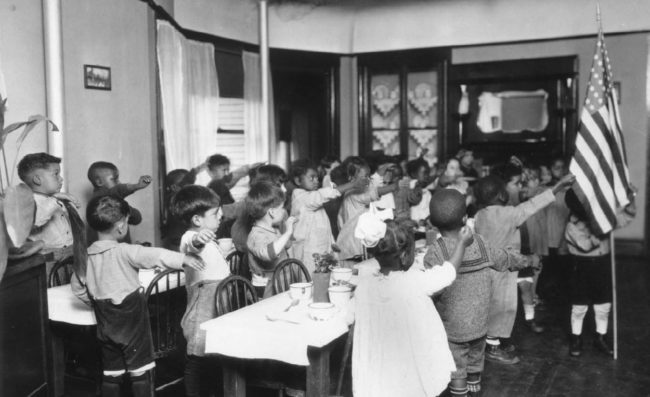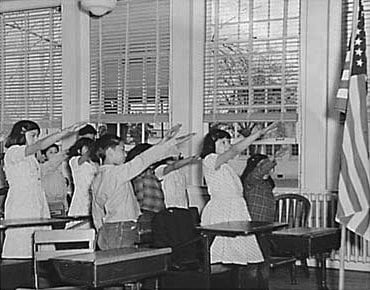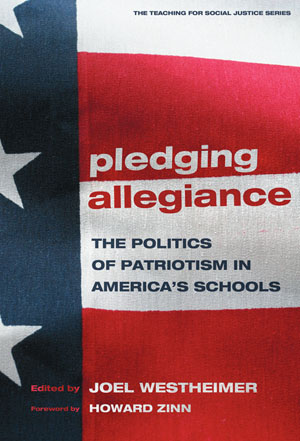I can remember my high school geometry teacher, Mr. Glandon, leading the class in the Pledge of Allegiance every morning. He ordered us to stand at attention, hands over our hearts. Anyone who was less than enthusiastic was branded an “opposition maker” — one of his favorite terms — and awarded demerits.
This was in Northern California in 1968, at the height of the Vietnam War, growing militancy of groups like the Black Panthers, and not long after the San Francisco counterculture’s “Summer of Love.”
For Mr. Glandon, forcing us to recite the Pledge was his small contribution in the war to preserve one version of America.

A group of children in a Los Angeles school in 1939 perform the extended-arm salute during the Pledge of Allegiance. Source: Getty Images
The Pledge has always been political. It was written in 1892 by Francis Bellamy, and published in the national magazine The Youth’s Companion to commemorate the 400th anniversary of Columbus’ first voyage.
President Benjamin Harrison proclaimed October 21 — the original Columbus Day — a national holiday, and designated schools to be the main sites of celebration. Why Columbus? Because he symbolized America’s supposed pioneer spirit and his voyage had made possible 400 years of “progress and freedom.”
. . . The original “Pledge to the Flag” was included in “The Official Programme for the National Columbian Public School Celebration of October 21, 1892.” On that 1892 day, with increasing numbers of eastern and southern European immigrants entering the United States, an estimated 10 million children first recited the Pledge.
Who Built America? includes the instructions from “The Official Programme”:
The pupils, in ordered ranks, hands to the side, face the Flag. Another signal is given; every pupil gives the Flag the military salute — right hand lifted, palm downward, to a line with the forehead and close to it. Standing thus, all repeat together, slowly, “I pledge allegiance to my Flag and the Republic for which it stands; one Nation indivisible, with Liberty and Justice for all.”
At the words, “to my Flag,” the right hand is extended gracefully, palm upward, toward the Flag, and remains in this gesture till the end of the affirmation; whereupon all hands immediately drop to the side.
Students were then to declare: “One Country! One Language! One Flag!” Presumably, the “One Language!” was English. Note that the words “under God” do not appear in the original Pledge. They were added during the Eisenhower administration in 1954 at the height of anti-communist hysteria.
According to the editors of Who Built America?, this arm extended flag salute was the norm in American schools until 1942, when the similarity with the fascist salute became a bit uncomfortable.
Possible Questions
Following the original Pledge recitation, ask students how it felt. Pose students some questions, for writing and/or discussion. These will vary depending on students’ background knowledge:
• What might be the purpose of a flag pledge? Who would push it and why?
• Read over the original words of the Pledge. In 1892, who did and did not have liberty and justice in the United States? [In the 1880s in the South, over 100 African Americans were lynched yearly; segregation was the norm and would soon be ratified by the U.S. Supreme Court in Plessy v. Ferguson. Women could not vote. In the previous 50 years, Mexicans had been stripped of land and property in what had been their country. Discrimination and violence against Chinese immigrants had grown increasingly severe. In the summer of 1892, 8,000 Pennsylvania National Guardsmen had helped Henry Clay Frick break the union at the Carnegie Steel Co. in Homestead, Pa.] How about in the 1920s, when the Pledge was introduced more widely into the schools?
• What does it mean to “pledge allegiance” to the flag? What would it mean to not pledge allegiance to the flag? [The Pledge bonds child and flag in a way that may inhibit young people from thinking critically about actions taken in the name of the flag — for example, the U.S. annexation of Hawaii, a few years after the Pledge was introduced. It attempts to “nationalize” identity, whereby students are encouraged to believe that they have more in common with other flagpledging Americans — say, tobacco growers in North Carolina — than with indigenous people organizing for land rights in Mexico. “We” are U.S. citizens; all others reside in the “They” category.]
• Why do you imagine there was an insistence on “One Language!” in addition to “One Country!” and “One Flag!”? To be an American must you give up your home language if it is not English? Is this being suggested in the original Pledge?
Shouldn’t students learn the critical skills to practice democracy, instead of just mouth platitudes in its honor?
[Select “Download Lesson” below to continue reading.] This reading was published by Rethinking Schools in an edition of Rethinking Schools magazine, (Summer 1996.) For more articles and lessons like “One Country! One Language! One Flag!,” subscribe to the Rethinking Schools magazine.
This reading was published by Rethinking Schools in an edition of Rethinking Schools magazine, (Summer 1996.) For more articles and lessons like “One Country! One Language! One Flag!,” subscribe to the Rethinking Schools magazine.
See related resources below and read The Scourge of Nationalism by Howard Zinn.









I am a member of the Dine’ Nation and as a small boy, as early as 8 years old, I thought it odd that I was forced to make this “pledge” each day in the public school I attended on my reservation in NW New Mexico. Over the years as I critically examined the pledge, I realized I didn’t feel right about it as it did not acknowledge the First Nations of this land, who have been here since Time Immemorial.
So, one day during planning for a cultural diversity training for teachers I decided to write my own pledge that I would heartily cross my heart and say. You are welcome to use it if you desire.
Pledge of Respect(native perspective)
I pledge Respect, to the Flags, of the Nations of this Land.
And to the Governments, for which They stand.
Many Nations, with many Sacred Ways. Sovereign,
with Freedom and Dignity for all.
Thank you, Aheehe’,
Arlie Neskahi
Dine’ Nation
Francis Bellamy may not be the author of the Pledge of Allegiance. There was a student named Frank Bellamy from Cherryvale , Kansas who in 1890 entered a contest as a class assignment . The contest was sponsored by “The Youth’s Companion” whose editor was Francis Bellamy. Frank Bellamy’s pledge, in his exact wordage and form ,was published in 1892. in that same magazine. It had no byline or credit . People assumed Francis Bellamy wrote it but in a book by Joyce Long there is compelling evidence that Frank bellamy was indeed the author.
https://www.kshs.org/kansapedia/case-for-the-pledge-of-allegiance/17789
Bill Bigelow is an excellent teacher who puts together great lessons that engage both students and teachers. I taught for over twenty+ years in Portland Public Schools, and was fortunate to have the opportunity to attend his district workshops…excellent concept…teachers teaching teachers.